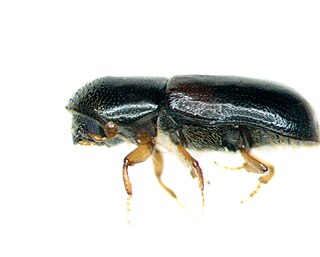
Ips confusus, known generally as the pinyon pine beetle or pinyon ips, is a species of typical bark beetle in the family Curculionidae. It is found in Central America and North America.

Hylesinus is a genus of crenulate bark beetles in the family Curculionidae. There are more than 180 described species in Hylesinus.

Xylosandrus crassiusculus, known generally as the Asian ambrosia beetle or granulate ambrosia beetle, is a species of tropical bark beetle in the family Curculionidae. It is native to Asia and has spread to Africa, Europe, Australasia and the Americas. The adult beetle is reddish-brown and some 2 to 3 mm long.

Dendroctonus brevicomis, the western pine beetle, is a species of crenulate bark beetle in the family Curculionidae. It is found in North America and parts of Mexico. It is known as a destructive pest of ponderosa and Coulter pine trees. When drought makes these pines more susceptible to infestations by D. brevicomis, there is an increased risk of forest fires due to dead trees.
Pityotrichus is a genus of typical bark beetles in the family Curculionidae. There are at least three described species in Pityotrichus.

Ambrosiodmus is a genus of typical bark beetles in the family Curculionidae. There are at least 100 described species in Ambrosiodmus.

Phloeotribus is a genus of crenulate bark beetles in the family Curculionidae. There are at least 150 described species in Phloeotribus.
Trichomagdalis is a genus of wedge-shaped bark weevils in the beetle family Curculionidae. There are about six described species in Trichomagdalis.

Trypodendron lineatum, known generally as striped ambrosia beetle, is a species of typical bark beetle in the family Curculionidae. Other common names include the two-striped timber beetle, conifer ambrosia beetle, and spruce timber beetle. It is found in Europe and North America.
Carphobius is a genus of crenulate bark beetles in the family Curculionidae. There are at least three described species in Carphobius.

Pityophthorus is a genus of typical bark beetles in the family Curculionidae. There are more than 540 described species in Pityophthorus.

Anthonomus aeneolus is a species of true weevil in the beetle family Curculionidae. It is found in North America. It normally develops within the flower buds of Solanum flowers, although eggs can be laid within galls on the plant. Larvae feed on the anthers of the flowers.

Pissodes nemorensis, known generally as the eastern pine weevil or deodar weevil, is a species of true weevil in the beetle family Curculionidae. It is found in North America and Africa. Deodar weevils are considered a forest pest in the United States, with adults and larvae feeding on a variety of coniferous tree species, including trees such as deodar cedar, loblolly pine, longleaf pine, sand pine, shortleaf pine, slash pine, and spruce pine Trees of all ages are susceptible to weevil infestations, while trees that are severely stressed by fire, drought, extreme cold, fusiform rust, wind damage, and other problems are prone to weevil infestation. In well-managed pine stands, deodar weevil infestations are sporadic, attacking only the suppressed and unhealthy trees throughout the area. Because they do not typically effect healthy trees, they do not usually alter traditional management strategies. Unlike many other forest pests in the eastern United States, deodar weevils are most active in the winter months, and this is often when sign of infestations can be seen. The best way to avoid a deodar weevil infestation is to maintain good tree and stand health: healthy trees do not typically face mortality or extensive damage from these pests. If an infestation has occurred, pesticides can be used in the fall as the weevils become active, but are typically not recommended.
Pseudothysanoes is a genus of typical bark beetles in the family Curculionidae. There are more than 100 described species in Pseudothysanoes.
Dendroctonus adjunctus, the roundheaded pine beetle, is a species of bark beetle in the family Curculionidae found in North America. A parasite, the roundheaded pine beetle feeds on and eventually kills pine trees of several species in Guatemala, Mexico, and the Southern United States.

Gnathotrichus materiarius, the American utilizable wood bark beetle, is an ambrosia beetle in the family Curculionidae. It is native to North America, but has been introduced to several European countries. It lives in symbiosis with the fungus Endomycopsis fasciculata, which adult beetles inoculate into the wood of host trees - the fungus then acts as the primary food source of the larvae and adults.
Scierus is a genus of crenulate bark beetles in the family Curculionidae. There are at least three described species in Scierus.
Alniphagus is a genus of crenulate bark beetles in the family Curculionidae. There are about eight described species in Alniphagus.

Xyleborinus saxesenii is a species of typical bark beetle in the family Curculionidae. Its common names include fruit-tree pinhole borer, common Eurasian ambrosia beetle, Asian ambrosia beetle, and lesser shot hole borer. It is native to the Palaearctic and has been introduced to North America. X. saxesenii is primarily a temperate zone species, although it does appears in some areas in more tropical climates. Length is about 2–2.4 mm (0.079–0.094 in), 2.6–3.0 times longer than wide.
Euplatypus parallelus, previously known as Platypus parallelus, is a species of ambrosia beetle in the weevil family Curculionidae. The adults and larvae form galleries in various species of tree and logs. It is native to Central and South America but has spread globally, is present in Africa and is well established in tropical Asia.











